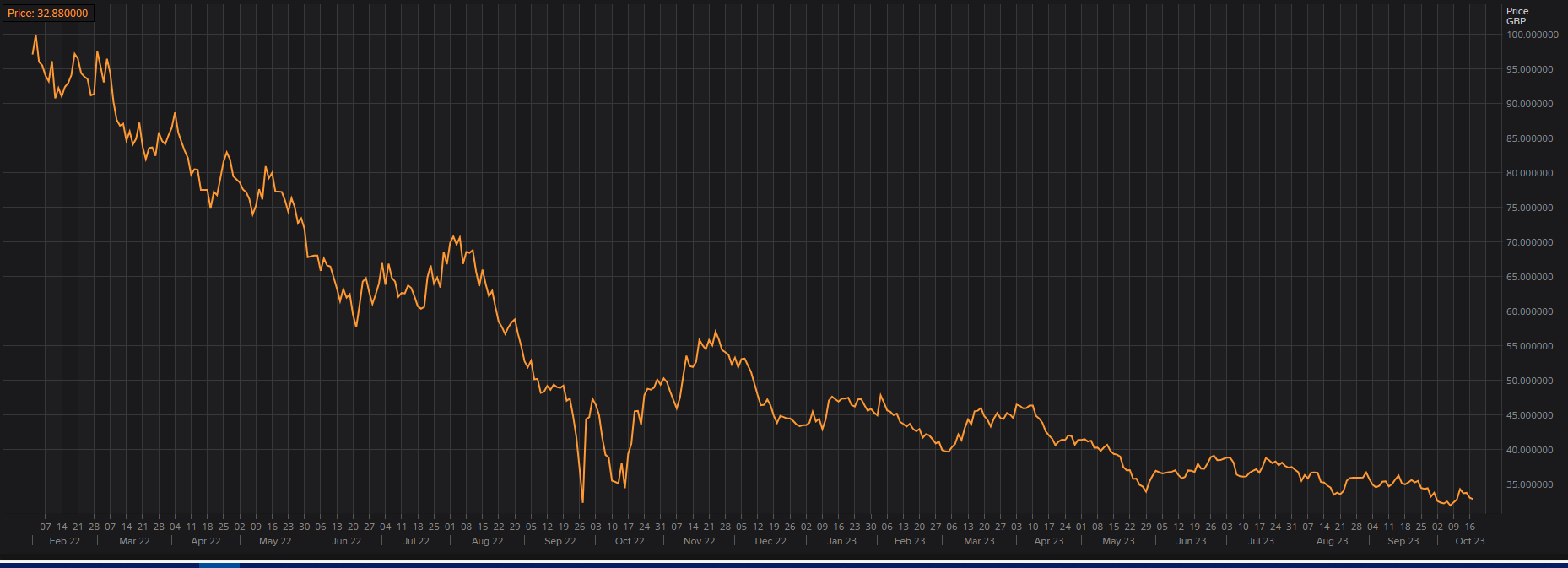Benstead on Bonds: the bond crash has broken records – is it finally time to buy?
The new bond bull market has had a series of false dawns – but could a recession next year finally trigger a rally for fixed income?
18th October 2023 11:08
by Sam Benstead from interactive investor

Bubble is not a term that is usually applied to the bond market – but with the benefit of hindsight, it seems that an enormous bond bubble had formed, which has now violently burst.
When bond prices rise, yields are compressed – but this is hardly attention-grabbing for most investors. So when yields on 10-year UK government bonds were around 0.4% at the start of 2020 (with inflation-adjusted returns therefore negative), your average investor barely paid attention.
- Invest with ii: Investing in Bonds | Free Regular Investing | Open a SIPP
Meanwhile, in 2019, the German government even issued negatively yielding bonds – this means that owners were guaranteed to lose money if they held the bonds to maturity, but could still shift them at a higher price (and lower yield) if they could find a buyer. Demand for bonds was so high that issuers could get away with such cheap debt.
The collapse in bond prices – caused by rising interest rates – has been dramatic. To take a handful of extreme examples: the price of TR73, a UK gilt issued in early 2022 yielding 1.3% and due to mature in 2073, has lost around 65% of its value. The longer the life of a bond, the higher the sensitivity to interest rate changes.
- Bond Watch: here’s why bond prices keep on falling
- Don’t expect UK interest rates to fall in 2024
- Bond Watch: what ‘higher for longer’ rates mean for bond prices
Bloomberg data shows that this has been the biggest bond crash in 150 years, with bonds now looking set to register three consecutive calendar years of negative returns. After falling 6% in 2022, global bonds, as measured by the Bloomberg Global Aggregate index in sterling, are down another 4% this year. The index fell 4% in 2021, making it three painful years for bond investors.
The price of the TR73 bond since issue is shown in the chart below. Issued near £100, the yield was around 1.3%. In order to bring that yield in line with market rates, investors sold the bond, taking it to just £32 today, which has now brought the yield up to around 4.5%.

Source: TR73 gilt price, data from Refinitiv. Past performance is no guide to future performance.
When will the economic pain come?
But despite the sharp rise in borrowing costs, economies remain in good shape. Growth is positive, unemployment low, and inflation is beginning to subside, especially in America. Positive economic data has therefore kept punishing the bond market, which is looking for signs that interest rate rises are having an effect and rates rises will pause and then rates will be cut.
Most economists thought a recession was guaranteed for 2023 and interest rates would even begin to fall this year. That prompted investors at the start of 2023 to argue that bonds were back after a painful 2022.
But a sudden rise in debt costs, for governments, corporates and households, can take a while to feed through into the economy, and while there has already been some stress on regional US banks, there could be other issues bubbling under the surface.
- Everything you need to know about investing in gilts
- Bank of England holds rates at 5.25% after inflation surprise
Chris Iggo, chair of the AXA Investment Management Investment Institute, says that high interest works with a lag, but there could “suddenly” be some pain, which will lead to rates being cut in 2024 to revive the economy. Rate cuts would be good for bond prices, especially the safest investment grade and developed-world government bonds, finally giving investors some capital growth alongside their income.
Iggo said: “In the 2006-07 peak in interest rates, they stayed there for a year, but the housing crisis did not happen immediately.
“In the UK now, the housing market is slowing. The Nationwide affordability index is back up to its highs, and is even more unaffordable than in 2009, so this should start to have an impact on prices and consumer spending.
“In the corporate sector, companies took out long-term debt when rates were low and have well-funded balance sheets, but when they come to refinance there could be some issues. Commercial real estate is already in trouble, however, due to the impact of the pandemic and work from home, as well as financing costs.”
Are bonds finally cheap enough?
Another fund manager I spoke to, James Penny, of TAM Asset Management, reckons that with US bond yields at about 5%, the market is cheap and ready for a rebound.
Penny told me that the last time US government bonds were this cheap was the summer of 2007, before bonds rallied 30% over the next 18 months when there was a recession. High yields indicate low bond prices.
- Bruce Stout: I’ve bought bargain bonds twice in 20 years, but won’t buy gilts now
- Six experts name their top five funds that should be in every portfolio
He says it was a great buying opportunity then, and it is one now as well, especially for investors looking to protect their portfolios.
“Markets always price in the rosiest scenario, which is that of a soft landing – a fall in inflation without a recession.
“But given that this has been the most aggressive rate-hiking cycle since the 1970s, many economists think that the impact will be on a six to 12-month lag, and damage to the economy is only just starting to filtering through.”
Penny has therefore been topping up on bonds, while remaining invested in the stock market as well.
“In the the bond market we’re focusing on high-quality government and corporate bonds, as well as some more speculative corporate bonds displaying attractive yields as well as recession-proof characteristics.
“We continue to top up US treasuries on weakness and have retained our volatility hedges in the portfolios, which have proven one of the best investments over the last quarter, and will continue to do so as this market struggles to price in either a soft or hard landing,” he said.
What happens next?
So, how bad could a recession be, if one eventually arrives? Iggo says that it will be your “off-the-shelf recession” - not terrible but not a walk in the park either.
He says that the impact of rising rates is cushioned by the high proportion of households that don’t have a mortgage (about four-fifths). However, he notes that the government does not have much firepower to boost the economy with spending, as deficits are high and borrowing costs are rising, and renters are also being hit in the pocket by higher mortgage costs for landlords.
He concludes: “There is a risk that GDP falls for two quarters and we go into a recession. Not a 1982-style crash, but something more mild. A typical recession.”
However, not everyone sees value in bonds today. Bruce Stout, manager of Murray International (LSE:MYI) investment trust, which invests across equities and bonds, said he has only bought bonds in “any material size” twice previously in his career: once in 2007 when 10-year gilts and 10-year treasuries were yielding 5.5%, and in 2014-15 when emerging debt looked “incredibly” attractive. But he will not buy gilts today.
“If you look at gilts over the last 70 years, then gilts have tended to trade with a 200 basis point real-risk premium to the inflation rate. So, if the inflation rate was 3%, bond yields would be 5%. So, we look at a 10-year gilt today at 4.5% and say, is that really accurately priced for whatever the inflation environment?
“It's very difficult to say. If inflation is much stickier than people think and it's here to stay at 4% or 5%, then maybe a gilt should be 6% or 7%. That would be fair value. To get it to be really attractive it might have to be higher,” he said.
These articles are provided for information purposes only. Occasionally, an opinion about whether to buy or sell a specific investment may be provided by third parties. The content is not intended to be a personal recommendation to buy or sell any financial instrument or product, or to adopt any investment strategy as it is not provided based on an assessment of your investing knowledge and experience, your financial situation or your investment objectives. The value of your investments, and the income derived from them, may go down as well as up. You may not get back all the money that you invest. The investments referred to in this article may not be suitable for all investors, and if in doubt, an investor should seek advice from a qualified investment adviser.
Full performance can be found on the company or index summary page on the interactive investor website. Simply click on the company's or index name highlighted in the article.